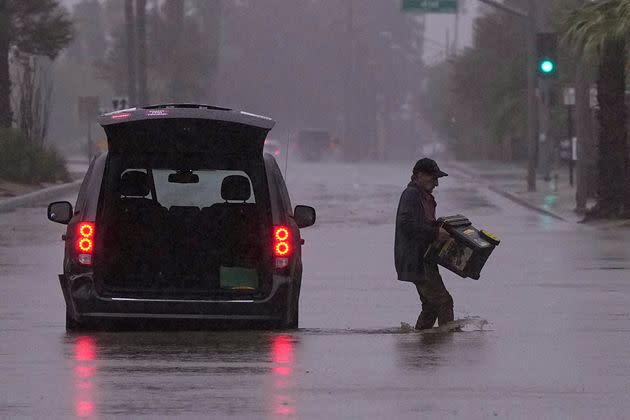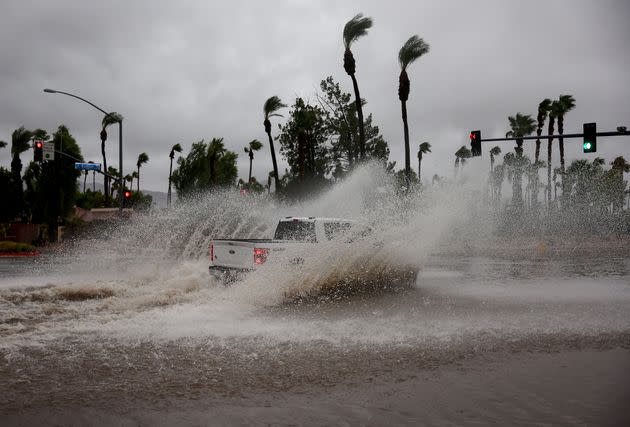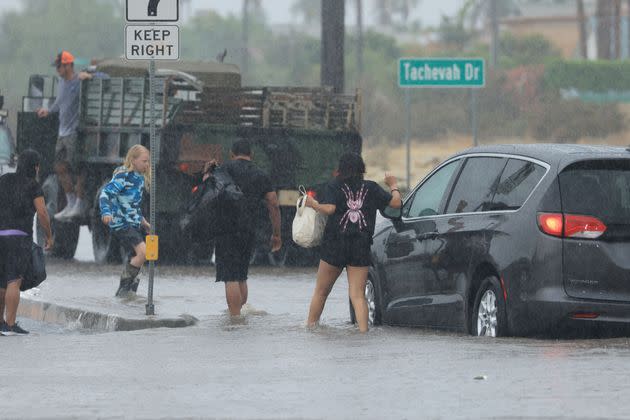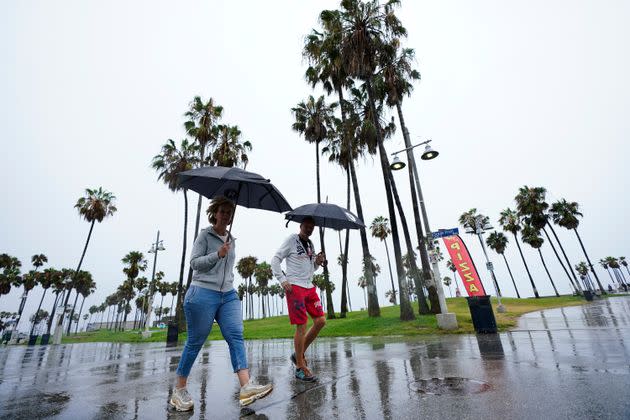California Braces For 'Life-Threatening' Floods As 'Hurriquake' Unsettles The State
Hilary was downgraded to a post-tropical cyclone early Monday, the National Hurricane Center said, as the threat of “life-threatening” flooding and debris flows remains in effect across the Southwestern U.S.
A wall of mud surged through California’s Sheep Canyon, carrying wood and debris along with it, as Hilary, then a tropical storm, dropped heavy rain across the region. https://t.co/Hlf8MSlN9Spic.twitter.com/mdtj3yWBEp
— CBS News (@CBSNews) August 21, 2023
“Localized flooding impacts, some significant, are also expected across northern portions of the Intermountain West into Tuesday morning,” the latest advisory states.

A motorist removes belongings from his vehicle after becoming stuck in a flooded street on Sunday in Palm Desert, California.
Tens of thousands were without power in Southern California on Sunday night after Hilary brought damaging winds, prompting warnings across the state and as far north as Oregon and Idaho.
Southern Californians were already met with an unpleasant surprise Sunday afternoon after a 5.1-magnitude earthquake hit the area.
The center of the storm made landfall in Southern California near Palm Springs on Sunday night after passing through Mexico. Emergency officials urged residents across the state to stay indoors and off flooded roads, and schools in Los Angeles and San Diego canceled classes on Monday.
“THIS IS LIFE THREATENING FLOODING!!!!!!” the Los Angeles office of the National Weather Service wrote on Sunday night. The agency declared a flash flood warning for parts of Los Angeles and Ventura counties into early Monday morning.
HEADS UP!!!!!
DANGEROUS FLOODING IN THE AREA BETWEEN POINT DUME...POINT MUGU...CAMARILLO...WESTLAKE VILLAGE...SOMIS AND SPANISH HILLS.
THIS IS LIFE THREATENING FLOODING!!!!!! #CAwx— NWS Los Angeles (@NWSLosAngeles) August 21, 2023

A vehicle drives through a flooded street in Cathedral City, California.
Rain totals for Hilary have smashed “virtually all rainfall daily records,” the National Weather Service Los Angeles said, noting that Lewis Ranch had recorded 7.04 inches of rain as of early Monday.
Rain totals for #Hilary as of 3AM, virtually all rainfall daily records have been broken thus far.
Some impressive totals:
Lewis Ranch: 7.04 in
Lake Palmdale: 5.98 in
UCLA: 4.26 in
Thousand Oaks: 3.29
Downtown LA: 2.38 in
For more details: https://t.co/n4b2WC6IV5— NWS Los Angeles (@NWSLosAngeles) August 21, 2023
San Diego also registered its wettest day on record Sunday, the city’s National Weather Service said.
Palm Springs had already over 3 inches of rain as of Sunday evening, according to The Associated Press, shattering monthly rainfall records. Its average annual rainfall is 4.66 inches.
Palm Springs Mayor Grace Garner told CNN the city is dealing with a “very extreme situation” given the flooding.
“There’s no way in or out of Palm Springs and that’s the case for the majority of the Coachella valley,” Garner said. “We’re all stuck.”

Motorists leave their vehicle stuck on a flooded road during heavy rains from Hilary in Palm Springs, California, on Aug. 20.
“You do not want to be out driving around, trying to cross flooded roads on vehicle or on foot,” Michael Brennan, the director of the National Hurricane Center, said during a news briefing, per The Associated Press. “Rainfall flooding has been the biggest killer in tropical storms and hurricanes in the United States in the past 10 years, and you don’t want to become a statistic.”

People walk along Venice Beach in the rain on Aug. 20, in Los Angeles.
Maximum sustained winds were near 45 mph, but weather officials expected the storm to weaken into a post-tropical cyclone by early Monday. Large parts of California and Nevada were expected to see 3 to 6 inches of rain, with some areas experiencing up to 10 inches in total.
The National Weather Service said those regions should expect “dangerous to catastrophic flooding.”
8 PM PDT Aug 20: Life-threatening and catastrophic flooding from #Hilary is ongoing over portions of the Southwestern U.S and Baja California. For more information, visit https://t.co/Oy8uoeSibMpic.twitter.com/CEJpx291QW
— NHC Eastern Pacific (@NHC_Pacific) August 21, 2023
The intensity of the storm and the fact that a hurricane was heading toward California at all has already sparked concerns from climate scientists who have long warned such events will only become more frequent and more severe as climate change continues. It’s too soon to say if Hilary was made more severe by our warmer world, but researchers released a shocking report in 2020 that found climate change is already making hurricanes stronger.
This is the desert.
The Coachella Valley and surrounding areas of Southern California are experiencing knee-deep flood waters from hours of rain cause by Tropical Storm #Hilary. pic.twitter.com/jgq1oP4eLh— The Weather Channel (@weatherchannel) August 21, 2023
Meanwhile, Southern California was struck by a 5.1-magnitude earthquake while households were already bracing for the impact of the storm. The quake hit about 4 miles southeast of Ojai at 2:41 p.m. local time, according to the U.S. Geological Survey, and was followed by several aftershocks.
#Hurriquake knocks over wine bottles at a grocery store in #Ojai. This comes as 12 earthquakes hit the area hours before #Hilary arrived in SoCal https://t.co/f2yEXI6mPKpic.twitter.com/8jtQMgLIE0
— FOX 11 Los Angeles (@FOXLA) August 21, 2023
The Ventura County Sheriff’s Office said no injuries or significant damage to buildings were immediately reported, following an aerial inspection of the area.
The National Hurricane Center is tracking three more tropical storms: Gert, Emily and Franklin, as well as another system in the eastern Gulf of Mexico that could turn into a “tropical depression or storm.”
“Tropical storm watches or warnings may be necessary on Monday for portions of the southern Texas and northern Mexico coastlines,” the Atlantic Tropical Weather Discussion states. “The chance of tropical development is high in the next 48 hours.”
